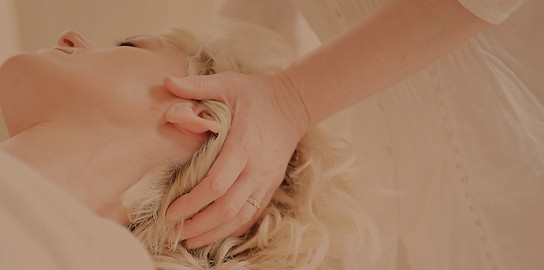
Craniosacral Therapy
Unlocking Your Body’s Natural Healing
A light touch for deep rest
What is craniosacral therapy?
Craniosacral therapy (CST) is a gentle, hands-on practice that honours your body’s innate wisdom and capacity for restoration. Rooted in osteopathic principles, CST is based on the understanding that our bodies carry stories: they can show up as physical tension, emotional holding, or unconscious patterns shaped by our life experiences.
Using an exceptionally light touch, I attune to the subtle movements and expressions within your system. This deep listening helps release tension and restrictions that may be interfering with your body’s natural flow of vitality. In this space of stillness and safety, your system is invited to rebalance itself, often resulting in meaningful shifts on both physical and emotional levels.
A natural complement for CST is a unique and powerful process called fascial unwinding. Our fascia is the intricate web of connective tissue that surrounds and connects every muscle, bone, nerve, and organ in the body. Over time, emotional stress, injuries, or postural patterns can cause the fascia to tighten or twist, leading to discomfort or dysfunction. Through a more noticeable contact and following your fascia's patterns, your body can express smooth, spontaneous movements as it begins to unwind, release, and reorganise itself. This can restore ease, fluidity, and alignment, accompanied by a sense of spaciousness and relief.
Find out more from the College of Cranio-Sacral Therapy and the Craniosacral Therapy Association.
Allow yourself to be
seen and understood without having to
say a word
Who can benefit from craniosacral therapy?
CST can support people of all ages and life stages. Whether you're experiencing
stress, pain, trauma, or simply feel out of balance, this therapy works with, not against, your body’s natural intelligence.
Common reasons people seek CST include:
-
Enhancing well-being: Supporting better sleep, improved energy, and a deeper sense of balance
-
Reducing stress and anxiety: Soothing the nervous system and releasing stored tension to foster deep relaxation, clarity, and resilience
-
Relieving chronic pain: Including headaches, migraines, neck and back tension, jaw discomfort (TMJ). CST often addresses the underlying causes of persistent symptoms
-
Support for trauma integration: Its gentle nature makes CST ideal for those seeking to process and recover from physical or emotional trauma at their own pace
-
Navigating life transitions: During seasons such as pregnancy, postpartum, menopause, or recovery from injury. CST helps your whole system adapt and recalibrate
-
Deepening mind-body connection: As CST increases awareness of your body’s inner world, it can nurture intuition, creativity, and trust in your own restorative capacities
CST is a great compliment to any medical care you may be under but is not a substitute for professional medical advice. Treatments are intended to work alongside the healthcare service your doctor provides. If you have a particular concern about your health, I always recommend that you consult your GP or relevant healthcare provider.
Meeting you where
you are, today


Bookings
If you would like to experience the benefits of CST for yourself, you can book through the links below.
More locations and availability coming soon!
Testimonials
What to expect during a craniosacral therapy appointment
During your first session, we will briefly discuss how you are feeling, your reasons for seeking CST, and any relevant medical history. If you are returning, we will catch up with how you have been feeling since the last session and your intention or focus for the session ahead. This is a confidential and supportive space, and every session is tailored to meet you exactly where you are.
For the treatment itself, you will remain fully clothed, lying comfortably on a treatment table. Typically, I may begin with taking light contact with your feet or shoulders to get a sense of your system. Next, I will take up contact at your sacrum (tail bone), solar plexus (upper abdomen), or heart centre to initiate the settling process. As I follow your system's expression, I will move to other areas of your body or cranium (head). As our bodies function as a whole, I may focus on areas other than where any symptoms may present. We will stay in open dialogue during treatment; permission will be sought as contacts are adapted and I encourage you to indicate if you prefer not to be touched in certain places or if you would like me to adjust contacts in any way.
During the appointment, you might experience a range of sensations, including warmth, tingling, pulsations, deep relaxation, or a sense of lightness or heaviness. Some people also report emotional releases, like tears or laughter, or a recollection of memories. It is common for people to fall asleep or drift into a deep state while others remain alert during the session. There’s no “right” way to experience CST.
We’ll take time at the end to gently close the session, talk through what may have arisen, and ensure you feel grounded. The effects of CST can continue unfolding in the hours and days afterward. Rest, hydration, and self-awareness can all support your integration.
Out of you head and into you body


Frequently asked questions
Is craniosacral therapy safe?
Yes. CST is extremely gentle and respects your body’s boundaries and pace. It is suitable for people of all ages and stages of health, including those who are pregnant or recovering from illness or injury.
How many sessions will I need?
Everyone is unique. Some people notice significant changes after just one or two sessions, while others benefit from regular support. Together, we can tailor a plan that fits your needs and goals.
Do I need to prepare for a CST session?
No special preparation is needed—simply wear comfortable clothes and bring an open mind. If you have specific symptoms or concerns, please share them before we begin.
Reach out if you would
like to know more
Qualifications and training
-
Tutor | College of Cranio-Sacral Therapy | October 2025 – Present
-
Diploma in Cranio-Sacral Therapy | College of Cranio-Sacral Therapy | July 2024 – July 2025
-
Fascial Unwinding Weekend Course | College of Cranio-Sacral Therapy | May 2025
-
Anatomy, Physiology and Pathology | College of Cranio-Sacral Therapy | February 2025













